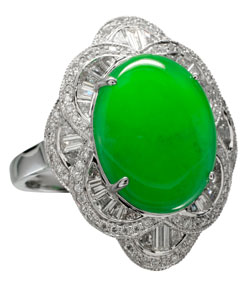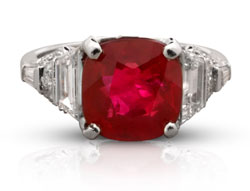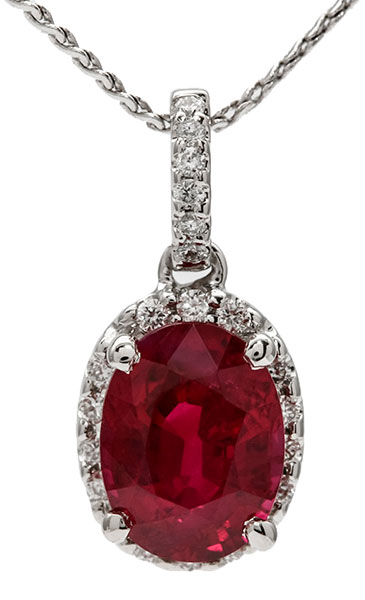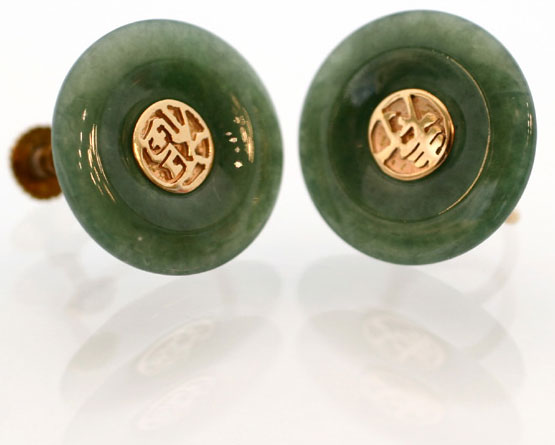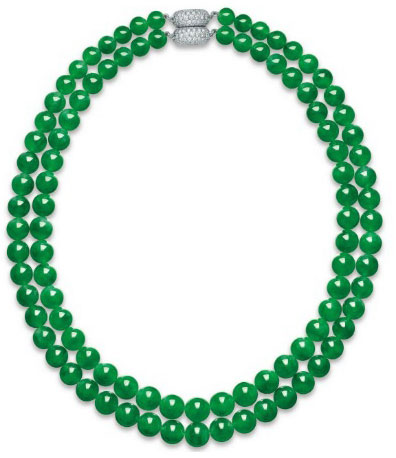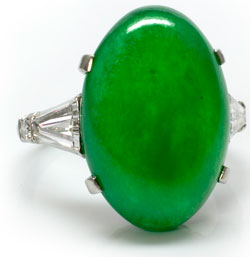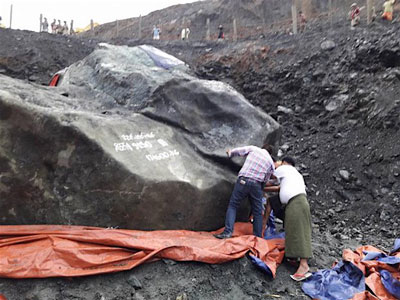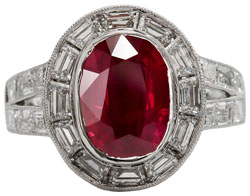Ruby and Jade
In October 2016, President Obama lifted trade sanctions on Burma, once again allowing Burmese rubies and jade to enter this country.
The sanctions were originally put in place to help suppress the lucrative mining industry operated by networks of military elites and drug lords, using forced labor by the poor. As the situation has improved, the sanctions were lifted.
Since more ruby and jade will now be entering the U.S., we're taking the opportunity to review these two gems.
Ruby
High-quality ruby can command the highest prices among colored gemstones. The ring above, with a 10.5-carat rare Burmese ruby as its center gem, fetched $10 million at auction last November.
Spectacular gems are often given names, which identify them even as they change hands over time. According to Christie's, this ruby was named Ratnaraj, meaning king of precious stones in Sanskrit, for the stone's significant size, fiery redness and flawless crystal structure.
At another recent auction, a 15.99-carat Jubilee Ruby sold for $14 million. The most expensive ruby to sell at auction was the 25.59-carat Sunrise Ruby, which fetched $30.38 million. All these rubies fell within the color range known as "pigeon-blood."
It's not by chance that all these top-price rubies came from mines in Burma (Myanmar). The Mogok Stone Tract has been legendary for producing exceptional rubies for centuries, with records of mining activities dating back to at least the 16th century. Today there are estimated to be more than 1000 mining operations in this area, ranging from large-scale mining companies to individual artisanal miners.
Notes for insurers:
Origin
"Burma rubies" have great status, but the source country is not an absolute indicator of quality. Every mine produces a wide range of quality. To command the best prices, a high-quality ruby must have its Burmese origin documented by a reliable lab, such as GIA, AGL, or Güblin. (Güblin recently opened a lab in New York, so it's no longer necessary to ship stones to Europe.)
Treatments
Rubies are usually subjected to heat treatments to improve their color. Some rubies may have fractures filled with a non-gem material to improve their clarity. Any treatments should be mentioned on the appraisal.
Lab-Grown or Mined
Lab-grown rubies are real ruby but they have a lower valuation than rubies from the earth. You want to be sure a lab-made ruby is not passed off as a mined stone.
Color
For ruby, color is the most important determinant of value. The color description is not just "red'. All corundum within the red range is ruby, while other corundum is called sapphire and is generally less valuable than ruby. An accurate gemological description of color, in terms of tone, saturation and hue, will distinguish ruby from pink sapphire.
"Pigeon blood" is a traditional term for a highly prized ruby color. Rubies in this range command the best prices. You may still encounter this on appraisals but the term may be used too loosely, applied to stones not even close to the appropriate color range. (Gemologists joke about how to apply this term: first you have to find a pigeon, then you have it kill it, then you have to compare the gem within the first 24 hours. . . .)
In any case, metaphoric or poetic terms are not acceptable color descriptions. For quality ruby, even slight variations in color can mean significant differences in valuation. A gemological description, giving tone, saturation, and hue, should look something like this:
medium dark (tone), vivid (saturation) purplish red (hue)
Composite
We've covered the topic of composite rubies in detail before. Check the appraisal for terms like composite or lead-filled, and be especially vigilant with jewelry purchased online, from big-box retailers, or at prices "too good to be true."
Jade
Jade has been made into decorative items since Neolithic times, but it wasn't until the 19th century that what is thought of as "jade" was revealed to be two completely different minerals—jadeite and nephrite.
Both are used in jewelry. Nephrite is comparatively common, and thus less expensive. Jadeite is much rarer and is more highly valued.
The world's largest producer of jadeite is Burma. The jadeite mining industry is said to account for half of the country's GDP.

Some of jadeite's colors |
Although jade is usually thought of as green, jadeite comes in many colors depending on the presence of other minerals. Color varieties include red, yellow, lavender, brown, orange, black and gray.
The same auction that sold the Ratnarag ruby discussed above also sold a remarkable two-strand jadeite necklace for $3.4 million. It is composed of 98 graduated jadeite beads. Part of its value comes from the accurate color-matching of the beads.
Another star of that auction was a jadeite jewelry set, which included necklace, earrings and ring, that was—as one source reported—"snapped up" for $3.11 million.
Jadeite and nephrite are exceptionally tough, meaning that they resist breakage under impact. In earlier times, they were even used to make tools and weapons.
Notes for Insurers:
Treatments
Jadeite may be impregnated with wax or plastic resins to imitate the luster and color of imperial jade. Sometimes these dyes can fade. Treatments should be mentioned on the appraisal.
Imitators
Stones like chalcedony may be dyed to look like jadeite. The cheapest jade imitations are simply glass or plastic.
Valuation
Proper grading of jade includes some qualities that don't apply to other gems. Besides color, there's also texture, transparency, and polish. Check your appraisal against the JISO 18 form to be sure all qualities are described.
The best jadeite is nearly transparent—you would be able to read print through a slice of high-quality jadeite, though the print may be slightly blurred. At the other end of the quality scale, jade may be totally opaque.
The most prized jadeite colors are suggested in such names as imperial jade, kingfisher jade, apple jade, or moss-in-snow jade. Again, these are poetic words inherited from an earlier time. Like other colored gems, jade's color should be described in terms of tone, saturation and hue.
Term confusion
Consumers may buy jewelry with stones called Korea jade, Colorado jade, Indian jade, Australian jade, Transvaal jade, or Honan jade, etc. These are not jade at all—they're just nicknames for other (probably green) minerals. True jade is either jadeite or nephrite.
FOR AGENTS & UNDERWRITERS
For rubies and jade—and all colored gems—it is essential that the appraisal be written by a gemologist experienced with colored gemstones and familiar with the current pricing, treatments and frauds. Most jewelers deal primarily with diamonds, and even a trained gemologist may have little experience with colored stones, especially jade or high-end sapphire.
There is always the danger that gem treatments will not be disclosed — by the supplier, the dealer, the jewelry manufacturer, the retailer, or the consumer — either out of ignorance or as deliberate fraud. The insurer is at the end of this chain and could wind up grossly overpaying a claim.
Be especially cautious with jewelry bought from sources like online auctions and shopping channels. Treatments are almost never mentioned in the advertising, and appraisals and lab reports from such sources should not be relied upon. For more discussion, see our issues on Ebay Shopping and TV Shopping.
The best appraisal includes the JISO 78/79 appraisal form, and is written by a qualified gemologist (GG, FGA+, or equivalent) who has additional insurance appraisal training. One course offering such additional training is the Certified Insurance Appraiser™ (CIA) course of the Jewelry Insurance Appraisal Institute.
See JISO 18 for its list of gems requiring special information for proper valuations. This form is a great checklist for verifying that all value elements are on the appraisal.
FOR ADJUSTERS
Synthetic rubies are worth much less than mined ones. Check the appraisal for the word synthetic, lab-made, man-made, or grown.
Fracture-filled rubies are penetrating the marketplace and may be passed off as untreated gems. Check the appraisal for the terms fracture-filled, treated, and clarity-enhanced.
Always have damaged stones examined by a reliable gemologist (who is not the selling jeweler) before settling a claim. For rubies, and all colored gems, be sure to consult a jeweler/appraiser who regularly deals with colored gemstones. The appraiser should also be a graduate gemologist and, preferably, a Certified Insurance Appraiser™.
And review "notes for insurers" in the story above.
©2000-2025, JCRS Inland Marine Solutions, Inc. All Rights Reserved. www.jcrs.com


